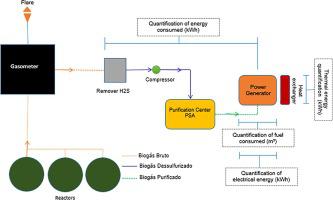Sustainable Energy Technologies and Assessments ( IF 7.1 ) Pub Date : 2020-06-22 , DOI: 10.1016/j.seta.2020.100774 Ricardo Dalpaz , Odorico Konrad , Carlos Cândido da Silva Cyrne , Henrique Panis Barzotto , Camila Hasan , Marildo Guerini Filho

|
Society strongly relies on energy to develop and maintain its basic activities. The demand for electricity expanded in the last 30 years, increasing the need for more diverse energy supply sources. The biogas produced from industrial, urban-organic, and agro-industrial waste is an alternative renewable energy source that can be used for bioenergy generation. This study aims to evaluate the electric and thermal energy generated in a cogeneration system, using biogas produced by the anaerobic digestion of agro-industrial waste as fuel. The cogeneration system included a shell-and-tube heat exchanger attached to an engine generator with nominal power of 60 kVA and nominal tension of 380 V. Biogas with three methane concentrations was used to conduct the experiments in an engine generator connected to an electric power grid, using a heat exchanger to measure the generated heat. In experiment I (68.54% methane), the raw biogas went through a desulfurization process and the system generated 2.04 kWh/m3 and 1.15 kWh/m3 of electric and thermal energy, respectively. In experiment II (83.46% methane), the methane concentration was increased by PSA, and the system generated 3.21 kWh/m3 and 1.57 kWh/m3 of electric and thermal energy, respectively. In experiment III (92.33% methane), the system generated 3.57 kWh/m3 and 1.67 kWh/m3 electric and thermal energy, respectively. Our experiments demonstrated that biogas with a high methane concentration can be efficiently used in the cogeneration of electric and thermal energy, boosting the energy potential of the fuel.
中文翻译:

利用沼气进行热电联产:分析农业工业废物产生的电能和热能
社会强烈依赖能量来发展和维持其基本活动。在过去的30年中,对电力的需求不断增长,从而增加了对更多多样化能源供应的需求。由工业,城市有机物和农业工业废物产生的沼气是可替代的可再生能源,可用于产生生物能源。这项研究的目的是评估利用热电联产系统产生的电能和热能,这些沼气是通过对农业工业废料进行厌氧消化而产生的沼气作为燃料。该热电联产系统包括连接到发动机发电机的壳管式热交换器,其额定功率为60 kVA,额定张力为380V。使用三种甲烷浓度的沼气在与电源相连的发动机发电机中进行实验格,使用热交换器测量产生的热量。在实验一(68.54%的甲烷)中,原始沼气经过脱硫过程,系统产生2.04 kWh / m分别为3和1.15 kWh / m 3的电能和热能。在实验II(83.46%的甲烷)中,通过PSA提高了甲烷浓度,系统分别产生了3.21 kWh / m 3和1.57 kWh / m 3的电能和热能。在实验III(甲烷为92.33%)中,系统分别产生3.57 kWh / m 3和1.67 kWh / m 3的电能和热能。我们的实验表明,甲烷浓度高的沼气可有效地用于电能和热能的热电联产中,从而提高了燃料的能源潜力。











































 京公网安备 11010802027423号
京公网安备 11010802027423号